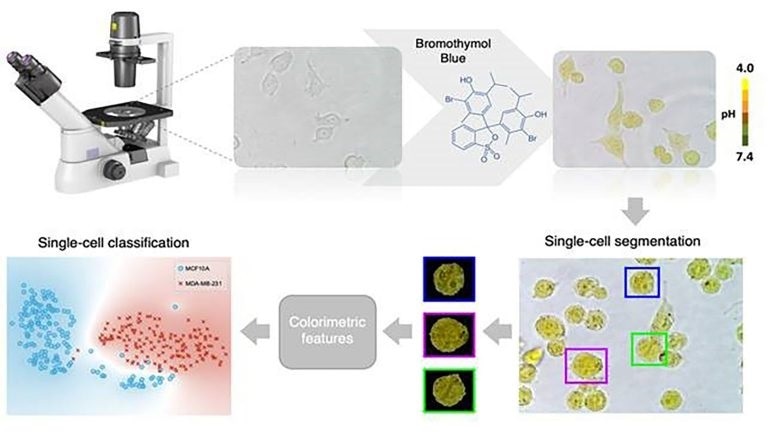Cancerous cells differ from healthy cells in various significant ways. This helps identify them as harmful. For example, a cancerous cell’s pH, or the level of acidity, differs from the pH of a healthy cell.

After being dyed with bromothymol blue, a single cell can be classified as either healthy or cancerous based on its color features. Image Credit: Yuri Belotti.
Scientists at the National University of Singapore devised a new technique to use machine learning to identify whether a single cell is cancerous by finding its pH. The study has been reported in the APL Bioengineering journal, from AIP Publishing.
The ability to identify single cells has acquired a paramount importance in the field of precision and personalized medicine. This is because it is the only way to account for the inherent heterogeneity associated with any biological specimen.”
Chwee Teck Lim, Study Author, National University of Singapore
According to Lim, other methods for investigating a single cell can trigger toxic effects or even destroy the cell. But their method can differentiate between cells originating from normal tissues and cells originating from cancerous tissues, as well as between different kinds of cancer, all this without killing the cells.
The technique depends on using bromothymol blue—a pH-sensitive dye that changes color based on the acidity of a solution—to treat the cells. Each kind of cell possesses its own distinctive fingerprint of red, green, and blue (RGB) depending on its intracellular acidity. The pH of a cell is modified by cancerous transformation; therefore, an unhealthy cell will differently react to bromothymol blue, leading to a characteristic shift of its RGB fingerprint.
To easily identify an undesirable shift, a machine learning algorithm can be trained to map combinations of colors to the disease state of each cell. This enables the health of a cell to be identified using only simple, standard equipment: a color camera and an inverted microscope.
Our method allowed us to classify single cells of various human tissues, both normal and cancerous, by focusing solely on the inherent acidity levels that each cell type tends to exhibit, and using simple and inexpensive equipment.”
Chwee Teck Lim, Study Author, National University of Singapore
Practical applications of this technique will require medical professionals to noninvasively obtain a sample of the cells in question.
One potential application of this technique would be in liquid biopsy, where tumor cells that escaped from the primary tumor can be isolated in a minimally invasive fashion from bodily fluids.”
Chwee Teck Lim, Study Author, National University of Singapore
The researchers hope to further advance the principle to try and identify various stages of malignancies from the cells. They visualize a real-time version of the process where cells suspended in a solution can be automatically identified and handled.
Source:
Journal reference:
Belotti, Y., et al. (2020) Machine learning based approach to pH imaging and classification of single cancer cells. APL Bioengineering. doi.org/10.1063/5.0031615.